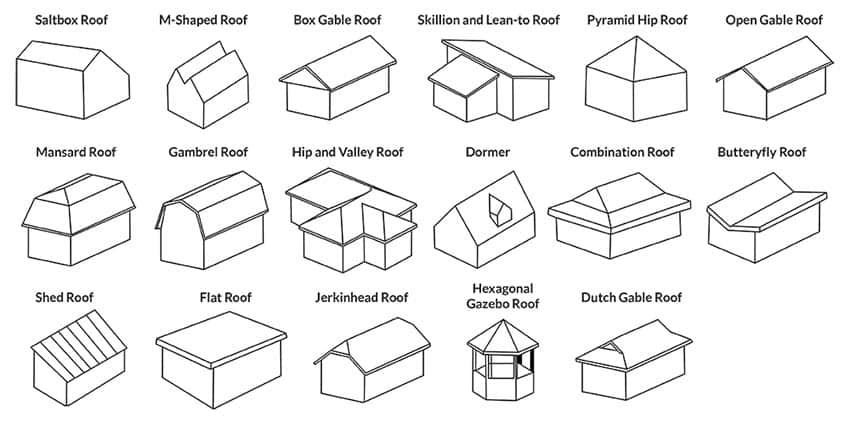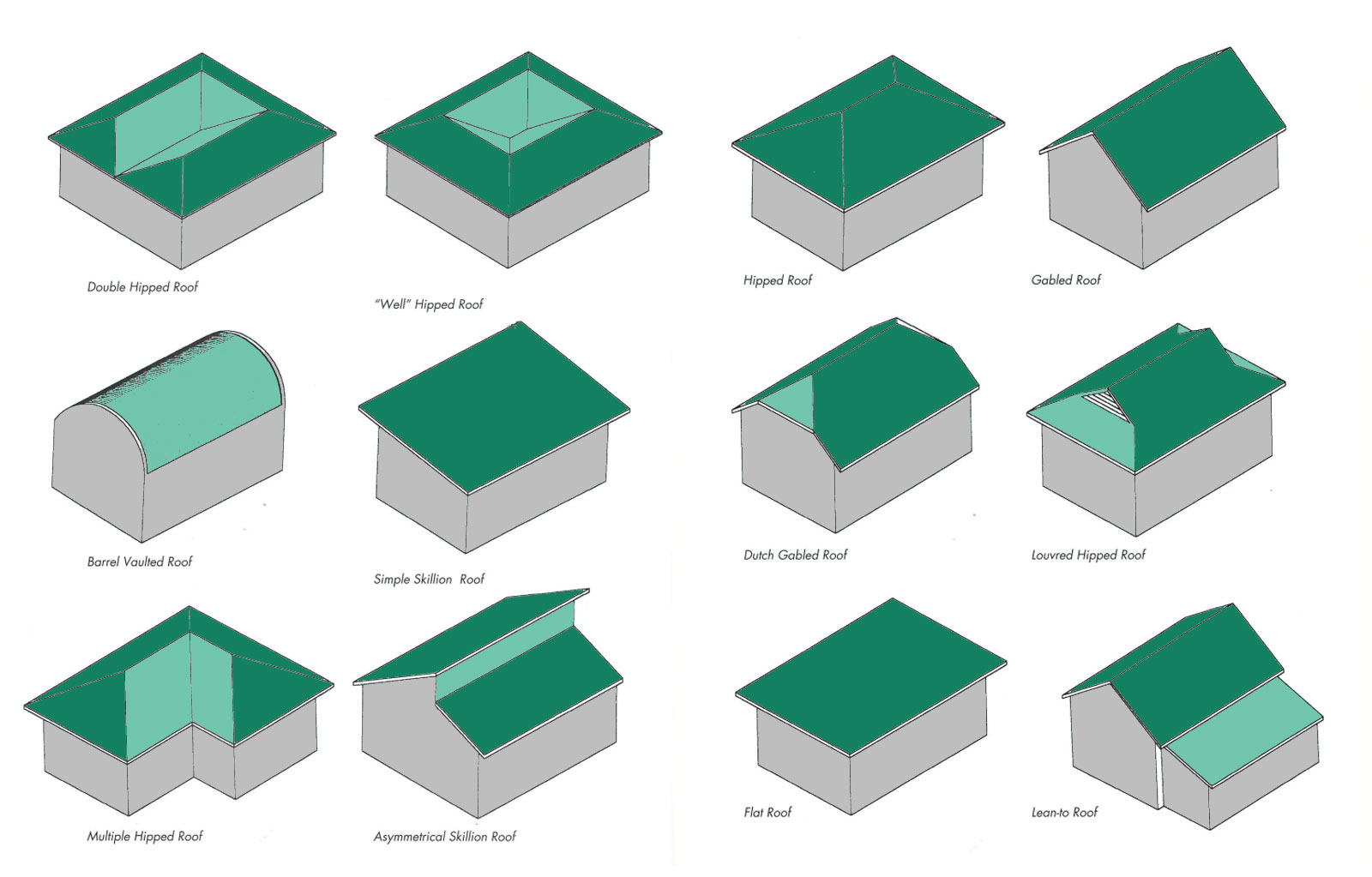30 Roof Types and Styles Examples and Illustrations Included
Table Of Content

Dormer windows project vertically from the roof, supplying natural light to attic or loft areas. Saltbox roofs are popular on the East Coast and in the northeast because of their ability to withstand heavy snow and rainfall. They are more expensive than traditional gable or hip roofs, but the distinct style adds value to a home.
Experts Guide to Roof Types and Their Benefits
There will always be at least a few degrees of slope to allow water to flow off the roof. Where the other architectural styles employ gutters at the end edges of the roof, flat roofs are equipped with scuppers, little openings at the edge of the flat roof that connect to downspouts. The principles of the bonnet roof match the mansard type of roof design architecture, but the slopes are reversed. The slopes at the top part of the roof are steep while the slopes at the bottom are much more gradual. Another example of a crossed gable roof is having a prominent gabled roof flanked on either side, or just one side, by a roof of a different slope. There is still just one ridge where the combination of roof slopes still meets.

FAQ About the Different Types of Roof Styles
A dome roof is a rare and distinctive roofing style, fashioned in the shape of a rounded, half-sphere. These are less commonly seen in residential areas but can be an excellent choice due to their durability and energy efficiency. Curved roofs are an emblem of modern architectural design, featuring a curved arch at either end.
Front Gable Roof Design
It is highly suitable even for houses which are exposed to high winds, frost or snow storms. Just like most metal roofs, this performs well in insulation – preventing heat from building up in the house under the hot sun. It reduces the peak everyday temperature and keeps the house cooler.
Roofing Materials
Gently sloping gable roofs are commonly used on ranch-style houses to make the rooftop less noticeable from the street. When choosing a roofing material, it's smart to choose a color and texture that blends with your siding. The rough texture and muted color of the cedar-shingle siding on this home are complemented by the roof's gray-brown shingles. We talk endlessly about roofing materials, colors, trends, and cost, but roof style is what really ties all of the pieces together and makes the roof. The roof style combines visual and structural elements to create the ultimate roof design to boost your curb appeal and reach your desired aesthetic. The roof style you choose can completely transform the exterior of your home.
However, one of the downsides of a gable roof is that it's prone to storm damage, especially if there is a significant overhang. However, having such a low slope means that flat roofs are often vulnerable to leaks and standing water. Gambrels provide great protection due to their steep slopes, which also allow for more attic space. Their construction requires fewer beams and columns than other roofs, which reduces the materials needed and installation cost. Hip roofs are structurally sound and can carry heavier loads compared with other roof styles. However, because they need to be engineered, these roofs are more expensive to build.

In fact, the standard or basic gable roof is the design that most other pitched roof types are built upon. A curved roof adds an extremely modern, interesting feature to any building. Modern roofs take advantage of the flexibility of metal materials, creating one large curved structure. Often incorporating two or more designs for aesthetics and practical reasons, combination roofs can feature a range of styles; a clerestory and hip roof, for example. If you are looking to boost your curb appeal, it is important you pair the right roofing materials with your roof style.
Curved
We’ll be going over dozens of roof styles loved by architects and builders alike. A pitched roof is a general term for roofs with a slope (from slight to very steep). A gable roof is a pitched roof with two sloping sides that meet at a ridge, creating end walls with a triangular extension (a gable) at the top. Gable roofs are typically symmetrical but can be asymmetrical in some architectural styles.
Is your roof typhoon-resistant? - Inquirer.net
Is your roof typhoon-resistant?.
Posted: Fri, 29 Nov 2013 08:00:00 GMT [source]
Different Types of Roofs with Pictures
Galvalume steel roofing is similar to galvanized, but instead of using purely zinc as a coating, it makes use of a mixture of aluminum and zinc. It can be used for most architectural styles whether it may be traditional or modern. However, it is not recommended for use in beach house or in coastal locations because corrosion. However, there are still a few disadvantages to using galvanized steel roofing. One is that, due to its weight, it is a bit more challenging to install compared to traditional materials. Aside from that, it requires professional services in terms of installation as it can get a bit heavy.
A salt box roof is asymmetrical in design, with one side being more of slightly sloping flat roof and the other more of a lean to, with gables at each end. A mansard roof, also known as a French roof, is a four-sided roof with a double slope on each side that meet forming a low-pitched roof. The sides are all equal length and come together at the top to form a ridge. Use a cross gable to accent different areas of the home, such as the garage, porch, or dormers.
Industrial and manufacturing buildings frequently have sawtooth roofs, with their glazing used as the main light source. Sawtooth roofs have a series of ridges with dual pitches either side, with glazing on the steeper sides to let as much light as possible into the building. Other recent projects with single-pitch roofs include a Kengo Kuma-designed student hub and an aquatics centre in the French Alps. Flat roofs can be insulated, which keeps heat from escaping the building when it’s cold outside. Combination roofs can offer several benefits, such as increased visual interest and design flexibility. It is often used in modern architecture because of its unique shape, which gives it a unique look.
Loft conversions: The ultimate guide FMB - FMB News
Loft conversions: The ultimate guide FMB.
Posted: Wed, 04 Nov 2020 11:22:48 GMT [source]
The type, material and shape of a roof are all significant to building an effective and desirable home design. In order to boost your home’s value and update its look, it is essential to know some basic facts on roofing design and how it can affect your home. Skillion roofs are similar to a shed roof in such a way that they both have a single flat surface with a steep and noticeable pitch. However, unlike the latter, skillion roofs can come in numerous planes—for example, the butterfly roof, with an inverted “V” shape, is known as a variation of the skillion roof.
The lower slope is steeper than the upper and overhangs the facade. Gabled roofs are made from two slopes that together form a triangular shape, and have been used for buildings since temples in ancient Greece. These have only one slope, as seen in FujiwaraMuro's project House in Gakuenmae, above.
If this area of the roof is not properly installed, it will only be a short period of time before water infiltrates inside. At the same time, it's often the humble shape of a shed roof that attracts designers, and it can work well in minimalist designs or when used in multiples. The result is a pyramid-shaped roof whose slope is often shallow to create more headroom, or steep to create a dramatic presence. Slate makes an elegant and attractive roof material for homes of many styles. If you love the look of slate roofs but not the price tag, composite material, which is made of slate and resins, features all the good looks of natural slate with easier installation and care.
We will also explore recommended roofing materials for the common roof types. Probably one of the most talked about roof types of them all, solar paneled roofing has come a long way. Derived from the sun’s radiation, solar shingles and panels are extremely beneficial for the environment as they are an efficient source of clean energy.
Aside from the added visual aesthetics, a jerkinhead roof also offers great stability. It can be used to create a refreshing roof garden, allowing the homeowner to maximize every inch of space in the house. This can also be used for other rooms in the house, but extra structures must be in place to hold the weight of the roof. Modular press formed panels are usually interlocked with each other to create shapes which are ready for direct application. Installation is done by using hidden fasteners which are also attached to the roof deck.
Comments
Post a Comment